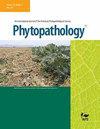Opportunities and Challenges in Combining Optical Sensing and Epidemiological Modeling.
IF 3.1
2区 农林科学
Q2 PLANT SCIENCES
Alexey Mikaberidze, C D Cruz, Ayalsew Zerihun, Abel Barreto, Pieter Beck, Rocío Calderón, Carlos Camino, Rebecca E Campbell, Stephanie K L Delalieux, Frédéric Fabre, Elin Falla, Stuart Fraser, Kaitlin M Gold, Carlos Gongora-Canul, Frédéric Hamelin, Dalphy O C Harteveld, Cheng-Fang Hong, Melen Leclerc, Da-Young Lee, Murillo Lobo, Anne-Katrin Mahlein, Emily McLay, Paul Melloy, Stephen Parnell, Uwe Rascher, Jack Rich, Irene Salotti, Samuel Soubeyrand, Susan Sprague, Antony Surano, Sandhya D Takooree, Thomas H Taylor, Suzanne Touzeau, Pablo J Zarco-Tejada, Nik J Cunniffe
求助PDF
{"title":"Opportunities and Challenges in Combining Optical Sensing and Epidemiological Modeling.","authors":"Alexey Mikaberidze, C D Cruz, Ayalsew Zerihun, Abel Barreto, Pieter Beck, Rocío Calderón, Carlos Camino, Rebecca E Campbell, Stephanie K L Delalieux, Frédéric Fabre, Elin Falla, Stuart Fraser, Kaitlin M Gold, Carlos Gongora-Canul, Frédéric Hamelin, Dalphy O C Harteveld, Cheng-Fang Hong, Melen Leclerc, Da-Young Lee, Murillo Lobo, Anne-Katrin Mahlein, Emily McLay, Paul Melloy, Stephen Parnell, Uwe Rascher, Jack Rich, Irene Salotti, Samuel Soubeyrand, Susan Sprague, Antony Surano, Sandhya D Takooree, Thomas H Taylor, Suzanne Touzeau, Pablo J Zarco-Tejada, Nik J Cunniffe","doi":"10.1094/PHYTO-11-24-0359-FI","DOIUrl":null,"url":null,"abstract":"<p><p>Plant diseases impair the yield and quality of crops and threaten the health of natural plant communities. Epidemiological models can predict disease and inform management. However, data are scarce, because traditional methods to measure plant diseases are resource intensive, which often limits model performance. Optical sensing offers a methodology to acquire detailed data on plant diseases across various spatial and temporal scales. Key technologies include multispectral, hyperspectral, and thermal imaging, as well as light detection and ranging; the associated sensors can be installed on ground-based platforms, uncrewed aerial vehicles, airplanes, and satellites. However, despite enormous potential for synergy, optical sensing and epidemiological modeling have rarely been integrated. To address this gap, we first review the state of the art to develop a common language accessible to both research communities. We then explore the opportunities and challenges in combining optical sensing with epidemiological modeling. We discuss how optical sensing can inform epidemiological modeling by improving model selection and parameterization and providing accurate maps of host plants. Epidemiological modeling can inform optical sensing by boosting measurement accuracy, improving data interpretation, and optimizing sensor deployment. We consider outstanding challenges in (A) identifying particular diseases; (B) data availability, quality, and resolution; (C) linking optical sensing and epidemiological modeling; and (D) emerging diseases. We conclude with recommendations to motivate and shape research and practice in both fields. Among other suggestions, we propose standardizing methods and protocols for optical sensing of plant health and developing open access databases including both optical sensing data and epidemiological models to foster cross-disciplinary work. [Formula: see text] Copyright © 2025 The Author(s). This is an open access article distributed under the CC BY-NC-ND 4.0 International license.</p>","PeriodicalId":20410,"journal":{"name":"Phytopathology","volume":" ","pages":"PHYTO11240359FI"},"PeriodicalIF":3.1000,"publicationDate":"2025-09-30","publicationTypes":"Journal Article","fieldsOfStudy":null,"isOpenAccess":false,"openAccessPdf":"","citationCount":"0","resultStr":null,"platform":"Semanticscholar","paperid":null,"PeriodicalName":"Phytopathology","FirstCategoryId":"97","ListUrlMain":"https://doi.org/10.1094/PHYTO-11-24-0359-FI","RegionNum":2,"RegionCategory":"农林科学","ArticlePicture":[],"TitleCN":null,"AbstractTextCN":null,"PMCID":null,"EPubDate":"","PubModel":"","JCR":"Q2","JCRName":"PLANT SCIENCES","Score":null,"Total":0}
引用次数: 0
引用
批量引用
Abstract
Plant diseases impair the yield and quality of crops and threaten the health of natural plant communities. Epidemiological models can predict disease and inform management. However, data are scarce, because traditional methods to measure plant diseases are resource intensive, which often limits model performance. Optical sensing offers a methodology to acquire detailed data on plant diseases across various spatial and temporal scales. Key technologies include multispectral, hyperspectral, and thermal imaging, as well as light detection and ranging; the associated sensors can be installed on ground-based platforms, uncrewed aerial vehicles, airplanes, and satellites. However, despite enormous potential for synergy, optical sensing and epidemiological modeling have rarely been integrated. To address this gap, we first review the state of the art to develop a common language accessible to both research communities. We then explore the opportunities and challenges in combining optical sensing with epidemiological modeling. We discuss how optical sensing can inform epidemiological modeling by improving model selection and parameterization and providing accurate maps of host plants. Epidemiological modeling can inform optical sensing by boosting measurement accuracy, improving data interpretation, and optimizing sensor deployment. We consider outstanding challenges in (A) identifying particular diseases; (B) data availability, quality, and resolution; (C) linking optical sensing and epidemiological modeling; and (D) emerging diseases. We conclude with recommendations to motivate and shape research and practice in both fields. Among other suggestions, we propose standardizing methods and protocols for optical sensing of plant health and developing open access databases including both optical sensing data and epidemiological models to foster cross-disciplinary work. [Formula: see text] Copyright © 2025 The Author(s). This is an open access article distributed under the CC BY-NC-ND 4.0 International license.
光学传感与流行病学建模相结合的机遇与挑战。
植物病害严重影响作物的产量和品质,威胁着天然植物群落的健康。流行病学模型可以预测疾病并为管理提供信息。然而,由于测量植物病害的传统方法是资源密集型的,这往往限制了模型的性能,因此数据很少。光学传感提供了一种获取植物病害在不同时空尺度上的详细数据的方法。关键技术包括多光谱、高光谱、热成像、光探测与测距;相关传感器可以安装在地面平台、无人驾驶飞行器、飞机和卫星上。然而,尽管有巨大的协同潜力,光学传感和流行病学建模很少结合起来。为了解决这一差距,我们首先回顾了最先进的技术,以开发两个研究团体都可以使用的共同语言。然后,我们探讨了将光学传感与流行病学建模相结合的机遇和挑战。我们讨论了光学传感如何通过改进模型选择和参数化以及提供宿主植物的准确地图来为流行病学建模提供信息。流行病学建模可以通过提高测量精度、改进数据解释和优化传感器部署来为光学传感提供信息。我们考虑以下方面的突出挑战:A)识别特定疾病;B)数据的可得性、质量和分辨率,C)将光学传感与流行病学建模联系起来,D)新出现的疾病。最后,我们提出了激励和塑造这两个领域的研究和实践的建议。在其他建议中,我们建议标准化植物健康光学传感的方法和协议,并开发开放获取数据库,包括光学传感数据和流行病学模型,以促进跨学科工作。
本文章由计算机程序翻译,如有差异,请以英文原文为准。
来源期刊
期刊介绍:
Phytopathology publishes articles on fundamental research that advances understanding of the nature of plant diseases, the agents that cause them, their spread, the losses they cause, and measures that can be used to control them. Phytopathology considers manuscripts covering all aspects of plant diseases including bacteriology, host-parasite biochemistry and cell biology, biological control, disease control and pest management, description of new pathogen species description of new pathogen species, ecology and population biology, epidemiology, disease etiology, host genetics and resistance, mycology, nematology, plant stress and abiotic disorders, postharvest pathology and mycotoxins, and virology. Papers dealing mainly with taxonomy, such as descriptions of new plant pathogen taxa are acceptable if they include plant disease research results such as pathogenicity, host range, etc. Taxonomic papers that focus on classification, identification, and nomenclature below the subspecies level may also be submitted to Phytopathology.

 求助内容:
求助内容: 应助结果提醒方式:
应助结果提醒方式:


